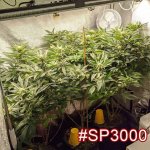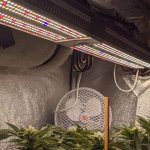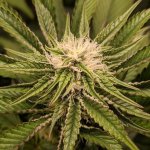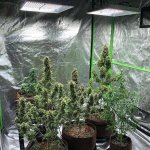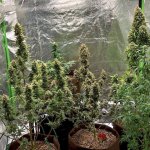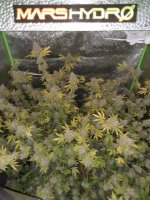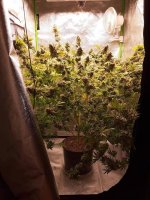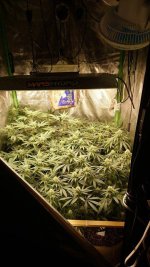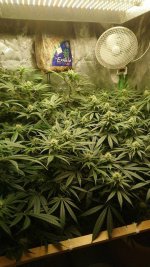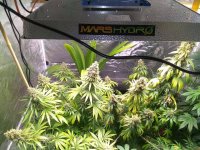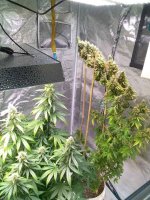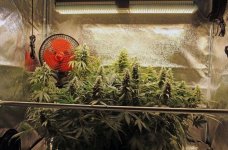You are using an out of date browser. It may not display this or other websites correctly.
You should upgrade or use an alternative browser.
You should upgrade or use an alternative browser.
Mars Hydro LED
- Thread starter Mars Hydro Led
- Start date
Feedback from SP3000. 
More chips on the same size lighting board. So the penetration could be better than old SP250.
Also more red chips to help promote flowering.
Purchase link: https://bit.ly/30DesD0
Coupon code"ICMAG"

More chips on the same size lighting board. So the penetration could be better than old SP250.
Also more red chips to help promote flowering.

Purchase link: https://bit.ly/30DesD0
Coupon code"ICMAG"
Attachments
Feedback from SP3000.
More chips on the same size lighting board. So the penetration could be better than old SP250.
Also more red chips to help promote flowering.
Purchase link: https://bit.ly/30DesD0
Coupon code"ICMAG"
Man, you guys should send me 2 of them so I can do a side by side With a 500w growers choice cmh....
Diode Wattage/ Penetration
Diode Wattage/ Penetration
MH,
what's the realtionship between diode wattage and penetration in your opinion?
Your newer lights have far better spectrums than the old ones, but I own one of your super old 5w diode units which had to be treated basically like a hps. If you hang them any closer to the plants they would fry everything.
Then came the reflector units with 3w diodes, which were not that strong and now we have lots of small diodes.
Is there a connection between higher watt diodes and deeper penetration?
Cheers
CC
Diode Wattage/ Penetration
MH,
what's the realtionship between diode wattage and penetration in your opinion?
Your newer lights have far better spectrums than the old ones, but I own one of your super old 5w diode units which had to be treated basically like a hps. If you hang them any closer to the plants they would fry everything.
Then came the reflector units with 3w diodes, which were not that strong and now we have lots of small diodes.
Is there a connection between higher watt diodes and deeper penetration?
Cheers
CC
MH,
what's the realtionship between diode wattage and penetration in your opinion?
Your newer lights have far better spectrums than the old ones, but I own one of your super old 5w diode units which had to be treated basically like a hps. If you hang them any closer to the plants they would fry everything.
Then came the reflector units with 3w diodes, which were not that strong and now we have lots of small diodes.
Is there a connection between higher watt diodes and deeper penetration?
Cheers
CC
Ah, now that's the great debate currently. As far as I can tell there are basically two different schools of thought on this. The first (and to me the most obvious thought), is that higher chip output = higher penetration, due to the inverse square law (https://en.wikipedia.org/wiki/Inverse-square_law). The other thought is that if you have more chips spread out at lower wattages per chip, then you hit the plants from more angles, thereby penetrating deeper into the canopy.
Personally I know that things aren't black and white, and feel that there is a combination of both theories in play here. In my own personal grow I use 4 HLG QB96's @ 120watts each in a 4'x4' space (total 480watts). Now the QB96's are quite different than the typical QB288, in that the boards are run ar the same wattages, but there are around 1/3 of the chips on the QB96 compared to the QB288, which means that each individual chip is being pushed 3x harder for more light output per chip. I believe that this gives better per-chip penetration into the canopy, and since I run 4 of them spaced out in a 4x4, I also get the advantage of hitting the plants from different angles.
Man, you guys should send me 2 of them so I can do a side by side With a 500w growers choice cmh....
Thanks for the comparison for SP250 with SF4000. It looks great.

There will be new giveaway coming soon.

Ah, now that's the great debate currently. As far as I can tell there are basically two different schools of thought on this. The first (and to me the most obvious thought), is that higher chip output = higher penetration, due to the inverse square law (https://en.wikipedia.org/wiki/Inverse-square_law). The other thought is that if you have more chips spread out at lower wattages per chip, then you hit the plants from more angles, thereby penetrating deeper into the canopy.
Personally I know that things aren't black and white, and feel that there is a combination of both theories in play here. In my own personal grow I use 4 HLG QB96's @ 120watts each in a 4'x4' space (total 480watts). Now the QB96's are quite different than the typical QB288, in that the boards are run ar the same wattages, but there are around 1/3 of the chips on the QB96 compared to the QB288, which means that each individual chip is being pushed 3x harder for more light output per chip. I believe that this gives better per-chip penetration into the canopy, and since I run 4 of them spaced out in a 4x4, I also get the advantage of hitting the plants from different angles.
Thanks for sharing your ideas.
 I also think the both theories are resonable.
I also think the both theories are resonable. SP250 and SP3000 use the same lighting board. SP3000 has more 200pcs chips. The light could be stronger. So the penetration could be deeper.
The right side plant is so weak compared to others. It might be gene issue? 
The light in picture is TS1000. It restock in USA and Germany warehouse now.
Purchase it here: https://bit.ly/30DesD0 Coupon: "ICMAG"

The light in picture is TS1000. It restock in USA and Germany warehouse now.

Purchase it here: https://bit.ly/30DesD0 Coupon: "ICMAG"
Attachments
SuperBadGrower
Active member
It doesn't matter how much power goes to individual diodes. 'Theoretically', one diode giving 1 w of light gives the "same" lumen output as 3 diodes giving .33 w. (Disregarding the fact that a diode is more efficient at lower power).
The only reason to use LESS diodes to give the SAME lumens (or PAR photons if you will), from any seller/manufacturer's perspective - especially these SMD PCBs - is to save $$. You cannot twist this any other way.
In the light sellers defense, there is also a point where it doesnt make sense anymore to put more diodes on pcb. Diminishing returns.
Imagine an LED driver which gives 200 watts.
Imagine a 2x2 tent
Imagine you put that 200 watt thru a 32x32mm COB. (lots of diodes packed densely together)
Now, imagine you put the same 200 watts thru a light fixture that is populated with 2000 diodes, spread out over the entire 2x2 (SMD diodes like the popular lm301b). It would be a "roof of diodes"
Whats gonna happen?
Its easier to visualize the inverse square law with images, but Steven from HLG explains it nicely.
If you have a light source that delivers 1000 PPF at 10 inches hanging height, in some spot in the area... When you go 10 inches DOWN from that spot you are left with approx 25% of the light. So, 10 inches down you'll read 250 ppf.
The COB, with 200w in a 32x32 mm area, will penetrate very deeply, right under it. Just like any intense single point light source like HPS. However, PPF will be poor outside the LED's hotspot, even at canopy level. Due to the intensity in a small area it needs to be higher from the plants than a spread out light source.
On the other hand if you have 20 2ft strips getting 10w each, will have very even light spread, but due to the inverse square law, it will not penetrate as deeply.
And yes reflective walls help but they are not a miracle cure.
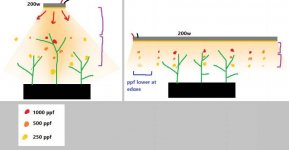
^All that is on a "macro" scale compared to diodes. But its the same story. 3 1w diodes put very closely together is the same as a 3w diode, for all intents & purposes.
In the end, does it matter? You're getting approx the same amount of photons into the area to produce biomass with... just distributed differently in the 3D space.
A diode run higher power will have a shorter lifespan and also worse lumen maintenance (= how much light is lost over time from degradation). But it is cheaper for you to buy.
Taken to the extreme: You wouldn't want a light that has a hanging height of 1 inch. It will penetrate only 1 inch into the canopy.
So what is the right hanging height then? It all depends what size plant (tallness) you are growing. For most indoor purposes the typical hanging heights of leds are OK.
Moreover, if you study light leaf penetration you'll find out it's actually green light and far red light which penetrate leaves. HPS is still king of penetration. Sounds dirty
The only reason to use LESS diodes to give the SAME lumens (or PAR photons if you will), from any seller/manufacturer's perspective - especially these SMD PCBs - is to save $$. You cannot twist this any other way.
In the light sellers defense, there is also a point where it doesnt make sense anymore to put more diodes on pcb. Diminishing returns.
Imagine an LED driver which gives 200 watts.
Imagine a 2x2 tent
Imagine you put that 200 watt thru a 32x32mm COB. (lots of diodes packed densely together)
Now, imagine you put the same 200 watts thru a light fixture that is populated with 2000 diodes, spread out over the entire 2x2 (SMD diodes like the popular lm301b). It would be a "roof of diodes"
Whats gonna happen?
Its easier to visualize the inverse square law with images, but Steven from HLG explains it nicely.
If you have a light source that delivers 1000 PPF at 10 inches hanging height, in some spot in the area... When you go 10 inches DOWN from that spot you are left with approx 25% of the light. So, 10 inches down you'll read 250 ppf.
The COB, with 200w in a 32x32 mm area, will penetrate very deeply, right under it. Just like any intense single point light source like HPS. However, PPF will be poor outside the LED's hotspot, even at canopy level. Due to the intensity in a small area it needs to be higher from the plants than a spread out light source.
On the other hand if you have 20 2ft strips getting 10w each, will have very even light spread, but due to the inverse square law, it will not penetrate as deeply.
And yes reflective walls help but they are not a miracle cure.

^All that is on a "macro" scale compared to diodes. But its the same story. 3 1w diodes put very closely together is the same as a 3w diode, for all intents & purposes.
In the end, does it matter? You're getting approx the same amount of photons into the area to produce biomass with... just distributed differently in the 3D space.
A diode run higher power will have a shorter lifespan and also worse lumen maintenance (= how much light is lost over time from degradation). But it is cheaper for you to buy.
Taken to the extreme: You wouldn't want a light that has a hanging height of 1 inch. It will penetrate only 1 inch into the canopy.
So what is the right hanging height then? It all depends what size plant (tallness) you are growing. For most indoor purposes the typical hanging heights of leds are OK.
Moreover, if you study light leaf penetration you'll find out it's actually green light and far red light which penetrate leaves. HPS is still king of penetration. Sounds dirty
Last edited:
Hi folks how is your relationship to marshydro.eu? They have the 2 x 4 tent in stock i'm looking for.
Thx chilliwilli
Thx chilliwilli
It doesn't matter how much power goes to individual diodes. 'Theoretically', one diode giving 1 w of light gives the "same" lumen output as 3 diodes giving .33 w. (Disregarding the fact that a diode is more efficient at lower power).
The only reason to use LESS diodes to give the SAME lumens (or PAR photons if you will), from any seller/manufacturer's perspective - especially these SMD PCBs - is to save $$. You cannot twist this any other way.
In the light sellers defense, there is also a point where it doesnt make sense anymore to put more diodes on pcb. Diminishing returns.
Imagine an LED driver which gives 200 watts.
Imagine a 2x2 tent
Imagine you put that 200 watt thru a 32x32mm COB. (lots of diodes packed densely together)
Now, imagine you put the same 200 watts thru a light fixture that is populated with 2000 diodes, spread out over the entire 2x2 (SMD diodes like the popular lm301b). It would be a "roof of diodes"
Whats gonna happen?
Its easier to visualize the inverse square law with images, but Steven from HLG explains it nicely.
If you have a light source that delivers 1000 PPF at 10 inches hanging height, in some spot in the area... When you go 10 inches DOWN from that spot you are left with approx 25% of the light. So, 10 inches down you'll read 250 ppf.
The COB, with 200w in a 32x32 mm area, will penetrate very deeply, right under it. Just like any intense single point light source like HPS. However, PPF will be poor outside the LED's hotspot, even at canopy level. Due to the intensity in a small area it needs to be higher from the plants than a spread out light source.
On the other hand if you have 20 2ft strips getting 10w each, will have very even light spread, but due to the inverse square law, it will not penetrate as deeply.
And yes reflective walls help but they are not a miracle cure.
View attachment 541931
^All that is on a "macro" scale compared to diodes. But its the same story. 3 1w diodes put very closely together is the same as a 3w diode, for all intents & purposes.
In the end, does it matter? You're getting approx the same amount of photons into the area to produce biomass with... just distributed differently in the 3D space.
A diode run higher power will have a shorter lifespan and also worse lumen maintenance (= how much light is lost over time from degradation). But it is cheaper for you to buy.
Taken to the extreme: You wouldn't want a light that has a hanging height of 1 inch. It will penetrate only 1 inch into the canopy.
So what is the right hanging height then? It all depends what size plant (tallness) you are growing. For most indoor purposes the typical hanging heights of leds are OK.
Moreover, if you study light leaf penetration you'll find out it's actually green light and far red light which penetrate leaves. HPS is still king of penetration. Sounds dirty
Thanks for sharing the knowledge here. Respect.

Hi folks how is your relationship to marshydro.eu? They have the 2 x 4 tent in stock i'm looking for.
Thx chilliwilli
It belongs to another department. We use different stock system.
There are only some SP250 in Australia warehouse. If you are in Australia and want to try old Sp250, pls PM me. I can help you. 
SP3000 are in stock in germany and USA warehouse now.
UK and Canada will restock around 3 weeks later.
Purchase link: https://bit.ly/30DesD0 Coupon"ICMAG"

SP3000 are in stock in germany and USA warehouse now.
UK and Canada will restock around 3 weeks later.
Purchase link: https://bit.ly/30DesD0 Coupon"ICMAG"
Attachments
Words from the grower: "This girl is ripe for the picking 11 weeks amnesia haze tsw 2000 awsome light".
Were there someone who grow the amnesia haze strain? Seems like a monster one.
https://bit.ly/30DesD0
Coupon"ICMAG"

Were there someone who grow the amnesia haze strain? Seems like a monster one.
https://bit.ly/30DesD0
Coupon"ICMAG"

Attachments
Attachments
After a long time no stock situation, we finally get through it. 
Now almost all overseas warehouses are full of stock. We don't know how long it could last. So if you want some lights recently, feel free to place the orders through this link: https://bit.ly/30DesD0 Coupon code"ICMAG"

Now almost all overseas warehouses are full of stock. We don't know how long it could last. So if you want some lights recently, feel free to place the orders through this link: https://bit.ly/30DesD0 Coupon code"ICMAG"

We plan to do a giveaway next month. 
Which light you most want to get? Any suggestion about the giveaway form? If we take the suggestion finally, there will be a suprise.
If we take the suggestion finally, there will be a suprise.  Welcome to share any your ideas about this.
Welcome to share any your ideas about this.

Which light you most want to get? Any suggestion about the giveaway form?
I'd love an SP 3000 for a giveaway
We plan to do a giveaway next month.
Which light you most want to get? Any suggestion about the giveaway form?If we take the suggestion finally, there will be a suprise.
Welcome to share any your ideas about this.

